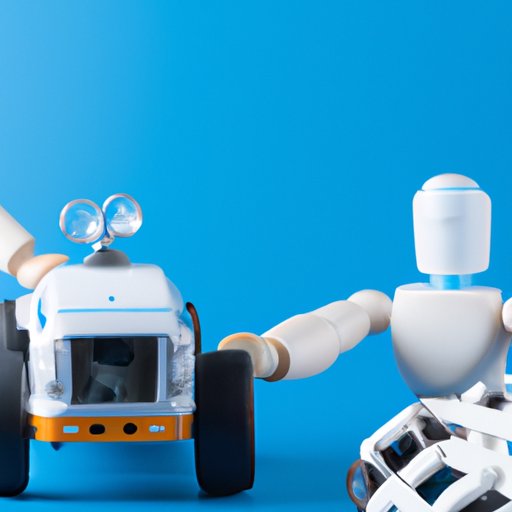Introduction
Robotics is a branch of engineering that deals with the design, construction, operation, and use of robots, as well as computer systems for their control, sensory feedback, and information processing. Robots can be used in a variety of applications, from manufacturing to medical care. In this article, we will explore some of the most common uses for robots and how they are impacting our lives.
Automation in Manufacturing
Robots have long been used in manufacturing to automate processes and increase production efficiency. According to a study by The Boston Consulting Group, automation has increased labor productivity in manufacturing by up to 25%. The advantages of automation include faster production, improved quality, and reduced costs. Automation also eliminates the need for manual labor, which reduces the risk of injury and fatigue.
Examples of automation in manufacturing include robotic welding and assembly, robotic painting, and robotic material handling. These robots can operate 24/7 without breaks, making them ideal for repetitive and hazardous tasks. Additionally, they can be programmed to carry out complex tasks, such as sorting and packing products.
Robot-Assisted Surgery
Robot-assisted surgery is becoming increasingly popular in the medical field. This type of surgery allows surgeons to perform delicate procedures with greater precision and accuracy than traditional methods. According to a study by the Journal of Robotic Surgery, robot-assisted surgery can reduce the risk of complications and speed up recovery time compared to traditional open surgery.
Examples of robot-assisted surgery include laparoscopic surgery, prostate surgery, and cardiac bypass surgery. In these procedures, a surgeon operates the robot from a console while the robot performs the actual surgery. This allows the surgeon to have greater control over the operation and to perform more precise movements.
Domestic and Home Care
Robots are being used in domestic and home care to help people with disabilities or those who are elderly or ill. These robots can provide assistance with daily activities, such as cooking, cleaning, and grocery shopping. They can also monitor the health of their users, remind them to take medications, and even provide emotional support.
Examples of domestic and home care robots include Paro, a therapeutic robot designed to provide companionship to the elderly; Jibo, an AI-powered robot that can answer questions and act as a personal assistant; and Aibo, a robotic pet that can recognize its owners and respond to voice commands.
Education and Research
Robots are also being used in education and research to engage students in STEM (science, technology, engineering, and math) subjects. Robotics can help students develop problem-solving skills, gain hands-on experience, and better understand complex concepts. According to a study by the International Journal of Advanced Robotic Systems, robots can also improve student motivation and engagement.
Examples of how robots are used in education and research include robotic kits, robotic competitions, and robotic tutors. These robots can teach students about coding and robotics, help them practice programming skills, and provide feedback on their performance.
Autonomous Vehicles
Autonomous vehicles, or self-driving cars, are another example of how robots are being used. These vehicles use sensors, cameras, and other technologies to navigate roads and avoid obstacles. According to a study by the National Highway Traffic Safety Administration, autonomous vehicles could reduce traffic fatalities by up to 90%.
Examples of autonomous vehicles include Google’s Waymo, which is currently being tested in several cities; Tesla’s Autopilot, which is available on some models; and Uber’s self-driving cars, which are being tested in Pittsburgh.
Conclusion
In conclusion, robots are being used in a wide range of applications, from manufacturing to medical care. They can automate processes, assist surgeons in performing delicate procedures, provide assistance to those in need, and even teach students about STEM subjects. Autonomous vehicles are also becoming increasingly common, offering the potential to reduce traffic fatalities.
The future of robotics is promising, as advancements in artificial intelligence and machine learning will allow robots to become more capable and intelligent. As robots become more widely used, they will continue to play an important role in our lives and revolutionize the way we live.
(Note: Is this article not meeting your expectations? Do you have knowledge or insights to share? Unlock new opportunities and expand your reach by joining our authors team. Click Registration to join us and share your expertise with our readers.)
